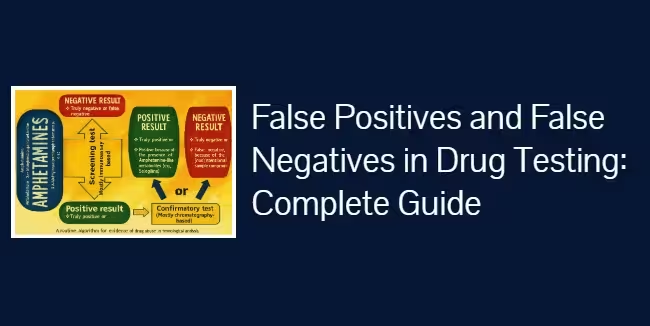False Positives & Negatives on a Drug Test Guide
False positives and false negatives in drug testing are important to understand because drug tests, while powerful tools for workplace safety, healthcare, and personal use, are not always perfect. Certain medications, supplements, and even foods can interfere with results, leading to a false positive (a drug is detected when none was used) or a false negative (a drug is missed even though it was used).
This guide explains both scenarios and provides a complete reference to help you understand how results can be influenced by medications, foods, supplements, and testing limitations.
Can Medications or Foods Cause False Drug Test Results?
Drug testing is an important tool for employers, healthcare providers, and individuals. But what many people don’t realize is that test results aren’t always black and white. Certain medications, supplements, and even foods can sometimes cause a false positive, while others can lead to a false negative—making it seem like a drug isn’t present when it actually is.
What Is a False Positive?
A false positive happens when a test shows a positive result for a drug that the individual hasn’t used. This usually occurs because the test reacts to a chemically similar substance.
Examples of false positives in drug testing:
-
Ibuprofen may trigger a positive for THC.
-
Poppy seeds can cause a positive for opiates.
-
Diphenhydramine (Benadryl) may appear as PCP.
What Is a False Negative?
A false negative happens when a drug test misses a drug that was actually used. This can occur if:
-
The drug dose was very small or below the test’s cutoff level.
-
The sample was diluted or tampered with.
-
The test does not detect synthetic or designer drugs (e.g., K2 Spice, Kratom).
-
The detection window has passed and the body has cleared the drug.
False Positives and False Negatives in Drug Testing by Drug
Below is a reference list of common drugs, with examples of substances that may cause false positives and reasons why a false negative may occur.
1. Dextromethorphan (DXM)
-
False Positives: Quinine, Diphenhydramine
-
False Negatives: Rapid metabolism, low dose below cutoff
2. Alcohol (ETG)
-
False Positives: Mouthwash, hand sanitizers, fermented foods
-
False Negatives: Diluted urine, lapse >80 hours, very small intake
3. THC (Marijuana)
-
False Positives: Ibuprofen, naproxen, hemp seed oil
-
False Negatives: Synthetic cannabinoids, single-use detection limits, sample dilution
4. Amphetamines
-
False Positives: Pseudoephedrine, ranitidine, bupropion
-
False Negatives: Short detection window, designer analogues not detected
5. Barbiturates
-
False Positives: Ibuprofen, naproxen
-
False Negatives: Short-acting barbiturates may be missed, low concentration
6. Benzodiazepines
-
False Positives: Sertraline, oxaprozin
-
False Negatives: Lorazepam or clonazepam often not detected by standard tests
7. Buprenorphine
-
False Positives: Other opioids
-
False Negatives: Low dose, insensitive tests, metabolite-only detection
8. Cocaine
-
False Positives: Topical anesthetics with cocaine derivatives
-
False Negatives: Short 1–2 day detection window, diluted samples
9. Fentanyl
-
False Positives: None commonly reported
-
False Negatives: Often missed by standard opiate screens, low-dose patch use
10. Heroin
-
False Positives: Poppy seeds, codeine
-
False Negatives: Metabolizes quickly to morphine, missed at high cutoff
11. Methadone
-
False Positives: Diphenhydramine, quetiapine
-
False Negatives: Missed if panel only tests for “opiates,” dilution
12. Methamphetamine
-
False Positives: Pseudoephedrine, selegiline, bupropion
-
False Negatives: Dilution, analogues may be missed
13. MDMA (Ecstasy)
-
False Positives: Pseudoephedrine, bupropion
-
False Negatives: Pills adulterated with no MDMA, short detection window
14. PCP
-
False Positives: Dextromethorphan, diphenhydramine, tramadol
-
False Negatives: Low cutoff, short detection window
15. Opiates (General)
-
False Positives: Poppy seeds, rifampin, quinolone antibiotics
-
False Negatives: Semi-synthetic opioids (oxycodone, fentanyl) often missed
16. Oxycodone
-
False Positives: Other opioids
-
False Negatives: May not be detected on generic opiate screens
17. LSD
-
False Positives: Antihistamines, tricyclic antidepressants
-
False Negatives: Very short 24-hour window, low concentration
18. Psilocybin (Mushrooms)
-
False Positives: None commonly reported
-
False Negatives: Rapid metabolism, not included in most panels
19. Tramadol
-
False Positives: Venlafaxine, dextromethorphan
-
False Negatives: Often not included in basic opiate screens
20. Special Cases (K2/Spice, Kratom, Bath Salts, Tianeptine, Zylazine, Delta-8 THC)
-
False Positives: Rarely reported on standard tests
-
False Negatives: Almost always missed on routine panels unless specifically tested
Why This Matters
Understanding false positives and false negatives in drug testing helps:
-
Employers avoid wrongful actions based on unconfirmed tests
-
Individuals protect themselves from accidental misinterpretation
-
Healthcare providers choose the right testing methods
For reliable results, always confirm unexpected outcomes with laboratory-based GC-MS or LC-MS testing.
Download the Full Guide
Q: What is a false positive on a drug test?
A false positive occurs when the test shows a positive result for a drug that was not actually used. This can happen due to certain medications, foods (like poppy seeds), or over-the-counter products that cross-react with the test.
Q: What is a false negative on a drug test?
A false negative occurs when a test fails to detect a drug that was used. This can happen if the dose is very low, the detection window has passed, or the test does not screen for certain synthetic drugs.
Q: Can foods really cause false positives?
Yes. Poppy seeds may cause positives for opiates, and hemp seed oil may cause positives for THC. Even everyday products like mouthwash or hand sanitizer can sometimes trigger positives for alcohol (ETG).
Q: How can I make sure drug test results are accurate?
Always confirm unexpected results with laboratory-based testing such as GC-MS or LC-MS. These methods are much more specific and can rule out false positives or negatives.
Q: Which drugs are most often missed by standard panels?
Designer and synthetic drugs such as K2 Spice, Kratom, bath salts (MDPV, a-PVP), Tianeptine, Zylazine, and Delta-8 THC are not usually detected by routine drug panels and require specialized tests.

